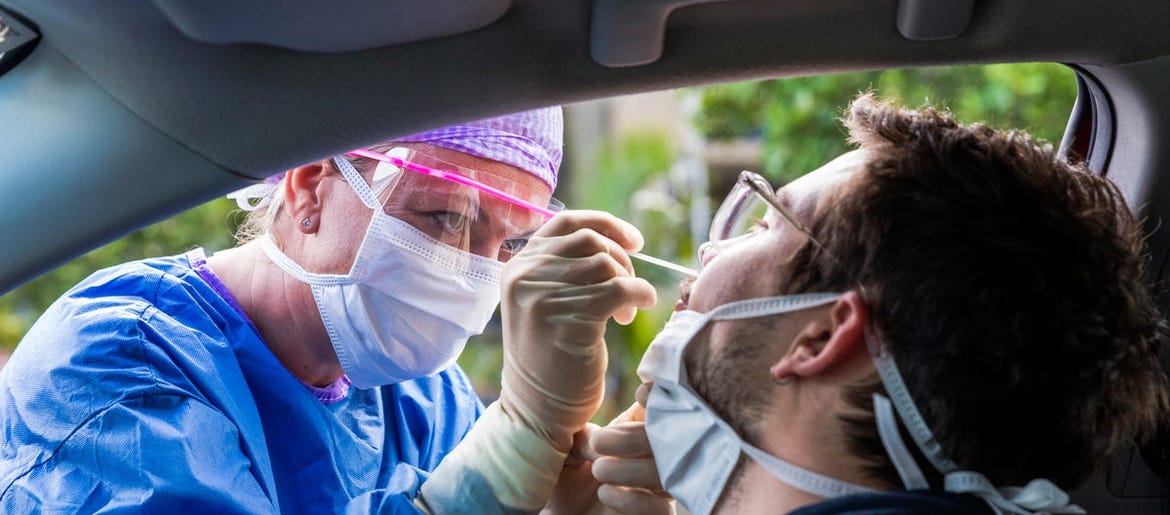Since mid-October, the rate of COVID-19 cases per 100,000 in Kitsap County— a valuable metric for school and extracurricular activity decision making — shot up from 42 on Oct. 19 to 78 on Nov. 1. By November 6, COVID-19 activity reached the “high” level, per Washington State guidelines.
At the same time, in addition to climbing case numbers, the percentage of COVID-19 tests yielding positive results in Kitsap County grew. While increased disease activity is prevalent among all age groups, the rate of new cases in children under age 18 has ballooned throughout October to its highest level. According to the Kitsap Public Health District, the main driver of rising case numbers is due to household spread among families.
As more community members come into contact with friends, relatives or co-workers who test positive for COVID-19, it is critical for the public to understand who needs testing. In an effort to keep our vulnerable community members safe and healthy, I hope to clear up some confusion in this column.
First, we must define what a “close contact” of someone who tested positive or lives in the household (a household contact) with someone who tested positive for COVID-19 actually means. According to the CDC, a close contact is: “Someone who was within 6 feet of an infected person for a cumulative total of 15 minutes or more over a 24-hour period* starting from 2 days before illness onset (or, for asymptomatic patients, 2 days prior to test specimen collection) until the time the patient is isolated.”
However, close contacts are also likely to be:
- Household contacts living/sleeping/eating in the same home, or sexual partners of a case,
- Healthcare workers who have had a breach in PPE or have not worn it while exposed to a case,
- People in closed settings, such as long-term care facilities, and other high-risk congregational/closed settings (e.g., prisons, shelters, hostels) where a case has been identified,
- Contacts of a case in other group settings (places of worship or indoor social events),
- Passengers on an aircraft sitting within 2 seats (in any direction) of the case, or those who used other public or shared transportation with a case.
If you meet criteria as a “close contact,” please get tested for COVID-19. Drive-through testing recently became available in our community. While awaiting results, self-isolate, wear a mask, and monitor yourself for symptoms.
While the “close contact” scenario seems straightforward, there is a great deal of confusion about who else should be tested for COVID-19, such as when you or your loved one is a “secondary” or “tertiary” contact of a person testing positive with whom you did not come into direct contact.
A secondary contact is a contact of a person in contact with a positive case. An example of this would be when the spouse of your co-worker tests positive. While you were not directly exposed to the sick individual, the possibility exists that your colleague could unknowingly spread disease to you while not showing symptoms of illness.
Approximately 32% of households with an index case go on to have a second one. Infection risk is 10 times higher for household contacts than non-household contacts. Risk of household transmission is 3 times higher for the adults than the children. Of course, spouses have the highest risk of developing active infection compared to children and other family members living in the household. The risk is highest if the individual with COVID-19 has developed symptoms, even if they are mild.
A “tertiary” contact is defined as a contact of a secondary contact. If we use the same co-worker scenario from above, then a child in your household would be an example of a tertiary contact of the ill spouse of your “asymptomatic” co-worker.
Outside the household, the risks of disease transmission are estimated roughly between 1-5%, depending on the degree of exposure. A recently released study in the journal Lancet found that among non-household contacts, exposure to more than one case, being spoken to by an index case for 30 min or longer, and sharing a vehicle with an index case were all situations associated with increased likelihood of COVID-19 transmission. Indirect contact, such as sharing a meal or a bathroom, were not independently associated with increased transmission risk in non-household contacts.
While preliminary data suggest some secondary and tertiary contacts will become infected, in reality, the practical yield decreases. Certainly, identification of positive cases and their “close contacts” should be prioritized. However, those who have travelled by plane, participated in large indoor gatherings, or spent time in close contact with others while not wearing a mask should be tested when they develop symptoms consistent with COVID-19.
In my opinion, Kitsap Public Health District Officer Dr. Gib Morrow said it best, “With COVID-19 spreading across our region, we need to take extra care of each other this season by keeping indoor gatherings to a minimum, wearing masks, and staying at least six feet from others.”
While there seems to be no end in sight for this interminable isolation, the decisions made during this upcoming holiday season will have a lasting impact. Our lives depend on each and every citizen doing their part to prevent spread of this disease. Get tested. Wear your mask. Wash your hands. Spend time outside. Doing these simple things can potentially saves lives.
The Kitsap County Emergency Operations Center and Kitsap Public Health District operate a drive-thru COVID-19 testing site at Pendergast Regional Park, 1199 Union Ave W, Bremerton. Pre-registration is required. To register, go to: testdirectly.com/kitsap. Find out more at kcowa.us/covidtesting.
